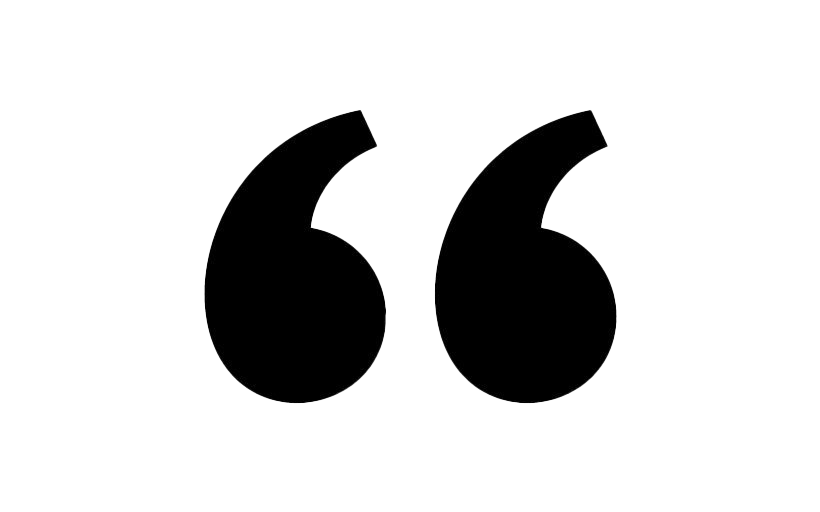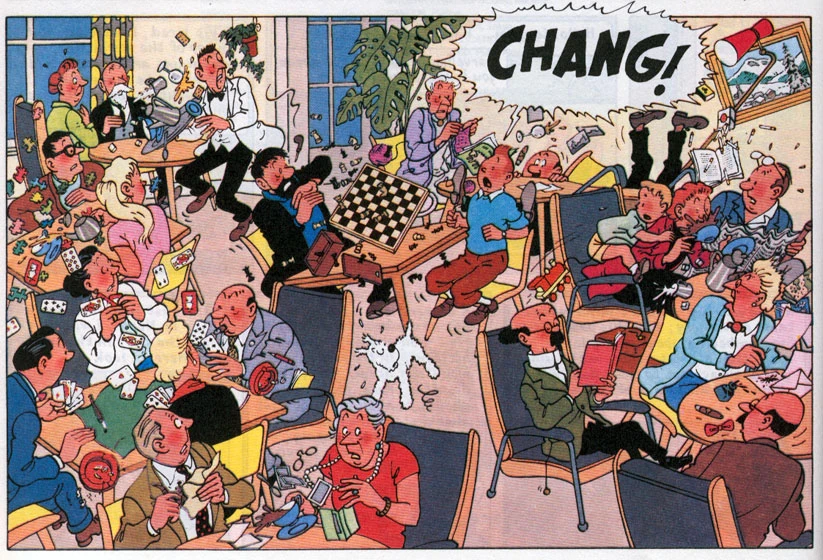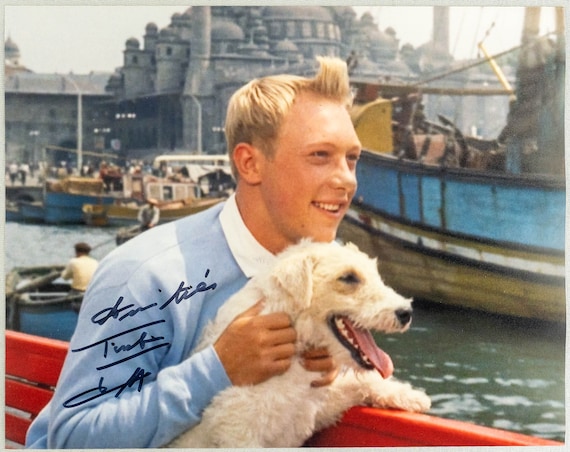


 The Adventures of Tintin (French: Les Aventures de Tintin) is a series of 24 comic albums created by Belgian cartoonist Georges Remi, who wrote under the pen name Hergé. The series was one of the most popular European comics of the 20th century. By 2007, a century after Hergé's birth in 1907, Tintin had been published in more than 70 languages with sales of more than 200 million copies, and had been adapted for radio, television, theatre, and film.
The Adventures of Tintin (French: Les Aventures de Tintin) is a series of 24 comic albums created by Belgian cartoonist Georges Remi, who wrote under the pen name Hergé. The series was one of the most popular European comics of the 20th century. By 2007, a century after Hergé's birth in 1907, Tintin had been published in more than 70 languages with sales of more than 200 million copies, and had been adapted for radio, television, theatre, and film.
The series first appeared in French on 10 January 1929 in Le Petit Vingtième ("The Little Twentieth"), a youth supplement to the Belgian newspaper Le Vingtième Siècle ("The Twentieth Century"). The success of the series led to serialised strips published in Belgium's leading newspaper Le Soir ("The Evening") and spun into a successful Tintin magazine. In 1950, Hergé created Studios Hergé, which produced the canonical versions of ten Tintin albums. Following Hergé's death in 1983, the final instalment of the series, Tintin and Alph-Art, was released posthumously.
The series is set during a largely realistic 20th century. Its protagonist is Tintin, a courageous young Belgian reporter and adventurer aided by his faithful dog Snowy ("Milou" in the original French edition). Other allies include the brash and cynical Captain Haddock, the intelligent but hearing-impaired Professor Calculus (French: Professeur Tournesol), incompetent detectives Thomson and Thompson (French: Dupont et Dupond), and the opera diva Bianca Castafiore.
 The series has been admired for its clean, expressive drawings in Hergé's signature ligne claire ("clear line") style. Its well-researched plots straddle a variety of genres: swashbuckling adventures with elements of fantasy, mysteries, political thrillers, and science fiction. The stories feature slapstick humour, offset by dashes of political or cultural commentary. ~ Wiki
The series has been admired for its clean, expressive drawings in Hergé's signature ligne claire ("clear line") style. Its well-researched plots straddle a variety of genres: swashbuckling adventures with elements of fantasy, mysteries, political thrillers, and science fiction. The stories feature slapstick humour, offset by dashes of political or cultural commentary. ~ Wiki


Tintin will go anywhere and everywhere for a good scoop. Indeed, he's been all around the globe (to all seven continents!) and then some, even going so far as to travel the moon, in the stories Destination Moon and Explorers on the Moon. What's particularly impressive is the level of research Hergé undertook as the latter story was published in 1954, fifteen years before Apollo 11.



Some of Tintin's other destinations include the United States, Japan, Tibet, Scotland, India, Egypt, Jamaica, Peru, and many others. A full list of locations in The Adventures of Tintin can be found here.
For all the poetic waxed about Tintin and the vivacious Captain Haddock, Tintin's dearest friend and confidant may very well be his dog, Snowy. Milou, Snowy's name in the original French, was the nickname of Hergé's first girlfriend.



 But despite all their camraderie, theirs, as with any other friendship, is not without its disagreements. One of their most common squabbles is over Snowy's habit of getting drunk off liquor. Tintin, as a certified teetotaler (or at least, an attempted one), find this behavior to be Snowy's most vexing. Similarly, Snowy occasionally acts the Donkey to Tintin's Shrek -- in some serious situations, he might be a bit too forthcoming with a witty comment or joking behavior, which is not met with much approval by Tintin when lives are at stake.
But despite all their camraderie, theirs, as with any other friendship, is not without its disagreements. One of their most common squabbles is over Snowy's habit of getting drunk off liquor. Tintin, as a certified teetotaler (or at least, an attempted one), find this behavior to be Snowy's most vexing. Similarly, Snowy occasionally acts the Donkey to Tintin's Shrek -- in some serious situations, he might be a bit too forthcoming with a witty comment or joking behavior, which is not met with much approval by Tintin when lives are at stake.
 Although Chang (French: Tchang) and Tintin only know each other for a short time, they form a deep bond which drives them to tears when they separate or are re-united [...] Chang was based on the Chinese artist Zhang Chongren, a real friend of Hergé's. ~ Wiki
Although Chang (French: Tchang) and Tintin only know each other for a short time, they form a deep bond which drives them to tears when they separate or are re-united [...] Chang was based on the Chinese artist Zhang Chongren, a real friend of Hergé's. ~ Wiki
Perhaps his most famous story is not the one in which he was introduced, but rather Tintin in Tibet.
 Hergé came to see Tintin in Tibet as his favourite volume in The Adventures of Tintin. He thought it an ode to friendship, composed "under the double sign of tenacity and friendship": "It's a story of friendship", Hergé said about his book years later, "the way people say, 'It's a love story'". ~ Wiki
Hergé came to see Tintin in Tibet as his favourite volume in The Adventures of Tintin. He thought it an ode to friendship, composed "under the double sign of tenacity and friendship": "It's a story of friendship", Hergé said about his book years later, "the way people say, 'It's a love story'". ~ Wiki

 Five feature-length Tintin films were made before Hergé's death in 1983 and one more in 2011.
Five feature-length Tintin films were made before Hergé's death in 1983 and one more in 2011.
The Crab with the Golden Claws (Le crabe aux pinces d'or) (1947) was the first successful attempt to adapt one of the comics into a feature film. Written and directed by Claude Misonne and João B Michiels, the film was a stop-motion puppet production created by a small Belgian studio.
Tintin and the Golden Fleece (Tintin et le mystère de la Toison d'Or) (1961), the first live-action Tintin film, was adapted not from one of Hergé's Adventures of Tintin but instead from an original script written by André Barret and Rémo Forlani. Directed by Jean-Jacques Vierne and starring Jean-Pierre Talbot as Tintin and Georges Wilson as Haddock, the plot involves Tintin travelling to Istanbul to collect the Golden Fleece, a ship left to Haddock in the will of his friend, Themistocle Paparanic. Whilst in the city however, Tintin and Haddock discover that a group of villains also want possession of the ship, believing that it would lead them to a hidden treasure.



Tintin and the Blue Oranges (Tintin et les oranges bleues) (1964), the second live action Tintin film, was released due to the success of the first. Again based upon an original script, once more by André Barret, it was directed by Philippe Condroyer and starred Talbot as Tintin and Jean Bouise as Haddock. The plot reveals a new invention, the blue orange, that can grow in the desert and solve world famines, devised by Calculus' friend, the Spanish Professor Zalamea. An emir whose interests are threatened by the invention of the blue orange proceeds to kidnap both Zalamea and Calculus, and Tintin and Haddock travel to Spain in order to rescue them.
Tintin and the Temple of the Sun (Tintin et le temple du soleil) (1969), the first traditional animation Tintin film, was adapted from two of Hergé's Adventures of Tintin: The Seven Crystal Balls and Prisoners of the Sun. The first full-length, animated film from Raymond Leblanc's Belvision, which had recently completed its television series based upon the Tintin stories; it was directed by Eddie Lateste and featured a musical score by the critically acclaimed composer François Rauber. The adaptation is mostly faithful, although the Seven Crystal Balls portion of the story was heavily condensed.
Tintin and the Lake of Sharks (Tintin et le lac aux requins) (1972), the second traditional animation Tintin film and the last Tintin release for nearly 40 years, it was based on an original script by Greg and directed by Raymond Leblanc. Belvision's second feature takes Tintin to Syldavia to outwit his old foe Rastapopoulos. While the look of the film is richer, the story is less convincing. The movie was subsequently adapted into a comic album made up of stills from the film.
The Adventures of Tintin: The Secret of the Unicorn (2011) was Steven Spielberg's motion capture 3D film based on three Hergé albums: The Crab with the Golden Claws (1941), The Secret of the Unicorn (1943), and Red Rackham's Treasure (1944). Peter Jackson's company Weta Digital provided the animation and special effects. The movie received positive reviews and was a box office success. ~ Wiki

Above: Tintin in The Adventures of Tintin (2011), modeled by Jamie Bell.

 Hergé is recognised as one of the leading cartoonists of the twentieth century. Most notably, Hergé's ligne claire style has been influential to creators of other Franco-Belgian comics. Contributors to Tintin magazine have employed ligne claire, and later artists Jacques Tardi, Yves Chaland, Jason Little, Phil Elliott, Martin Handford, Geof Darrow, Eric Heuvel, Garen Ewing, Joost Swarte, and others have produced works using it.
Hergé is recognised as one of the leading cartoonists of the twentieth century. Most notably, Hergé's ligne claire style has been influential to creators of other Franco-Belgian comics. Contributors to Tintin magazine have employed ligne claire, and later artists Jacques Tardi, Yves Chaland, Jason Little, Phil Elliott, Martin Handford, Geof Darrow, Eric Heuvel, Garen Ewing, Joost Swarte, and others have produced works using it.
In the wider art world, both Andy Warhol and Roy Lichtenstein have claimed Hergé as one of their most important influences. Lichtenstein made paintings based on fragments from Tintin comics, whilst Warhol used ligne claire and even made a series of paintings with Hergé as the subject. Warhol, who admired Tintin's "great political and satirical dimensions", said, "Hergé has influenced my work in the same way as Walt Disney. For me, Hergé was more than a comic strip artist".
Hergé has been lauded as "creating in art a powerful graphic record of the 20th century's tortured history" through his work on Tintin, whilst Maurice Horn's World Encyclopedia of Comics declares him to have "spear-headed the post-World War II renaissance of European comic art". French philosopher Michel Serres noted that the twenty-three completed Tintin albums constituted a "chef-d'oeuvre" ("masterpiece") to which "the work of no French novelist is comparable in importance or greatness". ~ Wiki

 Thanks for stopping by, enjoy some silly extras below!
Thanks for stopping by, enjoy some silly extras below!
